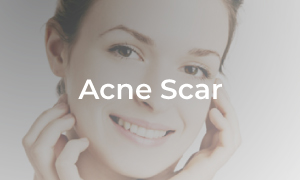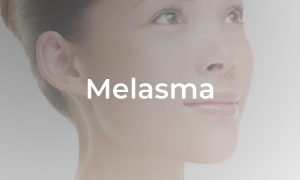Acne Scar
The primary cause of acne is the complex interaction between androgen hormones and the skin bacteria Propionibacterium acnes. Androgen hormones stimulate the sebaceous glands to overproduce sebum, which interacts with the skin bacteria, causing clogging of the skin pores. The clogged skin pores trap the inspissated keratin and lipid debris in the skin, leading to whiteheads and blackheads forming. Further inflammation leads to the formations of papule, pustule, nodule, and finally, scarring of the skin. While acne eventually will heal and subside, acne scars are permanent.
Acne scars usually consist of various features described as boxcar scar, ice pick scar, rolling scar, depressed scar, and atrophic scar. The two main characteristics of acne scarring are uneven skin texture and scar pigmentation. Because of the rough texture and ‘cratered’ skin surface, acne scars are very noticeable and difficult to cover even with makeup. Scar pigmentation caused by post-inflammatory hyperpigmentation (see Post-Inflammatory Hyperpigmentation) makes the acne scars even more pronounced.
Management of acne and management of acne scars go hand in hand.
Management of Acne
Anti-acne cleansers and anti-acne serums can help to clear up clogged pores and remove excess surface oil and sebum. For mild cases, topical agents that contain antibiotics, benzoyl peroxide, or retinoid are useful to control acne. For more recalcitrant cases, oral antibiotics help manage the bacteria that are responsible for acne. Oral retinoid is a powerful treatment modality for the most severe condition that fails to respond to other treatments. However, only specialists should prescribe oral retinoid due to its potentially serious side effects. The laser is an adjuvant therapy that is effective for moderate to severe cases of acne.
Management of Acne Scars
Recurrent and chronic acne will eventually lead to acne scarring. Once acne scarring occurs, the scars will be permanent. However, treatments are available that can improve the scars’ appearance and make them less noticeable. Treatment options for acne scars depending on the morphology and severity of the scarring.
Treatments of acne scars include laser therapy, fat graft, nanofat, and surgery
-
-
-
Fractional CO2 laser (see Fractional CO2 Laser): Currently, the fractional CO2 laser is the gold standard of acne scar treatment because of its effectiveness and short downtime. The fractional CO2 laser produces microthermal zones in the skin that induce coagulation and collagen rearrangement which improve the acne scars. Depends on the severity, laser treatment may require one session only or may require multiple sessions. Downtime is around 3-7 days. Usually, a total of 1-5 sessions are required. The interval between different sessions is one month.
-
Fat Graft (see Fat Graft)
-
Nanofat (see Nanofat)
-
Surgery: Excision, punch excision, and subcision are the surgical procedures performed to remove acne scars. Surgery is the treatment of choice for boxcar scars, ice pick scars, or depressed scars that are not amenable to other treatment modalities.
-
-








